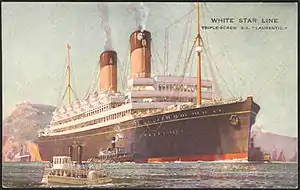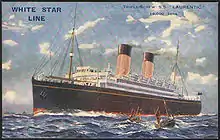SS Laurentic (1927)
The second SS Laurentic was a 18,724 GRT steam ocean liner built in 1927 by Harland and Wolff, Belfast, for the White Star Line.[1] She was the last steamship to be built for White Star Line.[2]
 Laurentic | |
| History | |
|---|---|
| Name: | Laurentic |
| Owner: |
|
| Operator: |
|
| Port of registry: | Liverpool |
| Route: | Liverpool — Québec — Montreal |
| Builder: | Harland and Wolff, Belfast |
| Yard number: | 470 |
| Launched: | 16 June 1927 |
| Completed: | 1 November 1927 |
| Maiden voyage: | 12 November 1927 |
| In service: | 1927 |
| Out of service: | 1940 |
| Identification: |
|
| Fate: | torpedoed by U-99 3–4 November 1940 |
| Notes: | The last steamship built for White Star Line and the last White Star Line ship to sink. |
| General characteristics | |
| Type: | ocean liner |
| Tonnage: | |
| Length: | 578.2 ft (176.2 m) |
| Beam: | 75.4 ft (23.0 m) |
| Depth: | 40.6 ft (12.4 m) |
| Decks: | 4 decks |
| Propulsion: |
|
| Speed: | 16 knots (30 km/h) |
| Capacity: |
|
| Sensors and processing systems: |
|
| Armament: | |
She sailed between Liverpool and Canada from 1927 to 1936. After the merger of the White Star Line with Cunard she was used mainly as a cruise ship. From December 1935 she was laid up in Liverpool.
In 1939 the Admiralty requisitioned her and had her converted into an armed merchant cruiser for the Royal Navy. On 3–4 November 1940 a U-boat torpedoed her off the west coast of Ireland when she was on a rescue mission for another ship that had been torpedoed. She sank with the loss of 49 of her complement.
Building
The building of this ship is peculiar in several respects. It was the only time in 60 years that White Star Line ordered from Harland and Wolff on the basis of a defined budget. Laurentic thus appeared to be a ship at a discount, which was unusual in the history of the company.[3] Mysteriously she was built with the hull number 470, while Doric, put into service in 1923 (four years before her), was hull number 573. This would suggest that order for Laurentic was made in the early 1920s and that the ship was unfinished for more than five years. The cause of such a long delay is unknown.[4]
Laurentic looked like Doric, but she was bunkered with coal at a time when most new steamships were fueled by oil. Her propulsion is similar to that of the first Laurentic, completed in 1909.[5] She had three screws. A pair of four-cylinder triple-expansion steam engines drove her port and starboard screws. Exhaust steam from their low-pressure cylinders fed one low-pressure steam turbine, which drove her middle screw.[6][7]
The 1926 United Kingdom general strike delayed her building. She was eventually launched without ceremony on 16 June 1927. She was completed five months later on 1 November, after which she left Belfast for Liverpool carrying representatives of White Star Line and Harland and Wolff.[4]
Passenger career

On 31 December 1927 she began her maiden voyage, sailing from Liverpool and cruising around the Mediterranean before returning to Liverpool on 17 April 1928. On 27 April 1928 she was transferred to the Liverpool – Quebec – Montreal route. This was her route for most of her commercial career, but also occasionally cruised the Mediterranean. In January 1931 it was expected that the ship be transferred to a Mediterranean cruise, but the Great Depression made the service unprofitable.
On 25 February 1934 she made her last crossing on a regular line for the White Star between Boston, Halifax, Nova Scotia and Liverpool. She was then assigned to cruising.[8] In March of that year, she transported 700 pilgrims from Dublin to Rome for the Easter celebrations.[9]
In 1933 or 1934 there was a Worldwide revision of the code letters of merchant ships. Laurentic's code letters KWPV were superseded by the new call sign GNJT.[10]
White Star Line and Cunard Line merged in 1934. Laurentic was docked in December 1935 and served the following September as troop ship to Palestine.[11] In this capacity she made her last trip for Cunard-White Star Line in December of that year. In 1937 she took part in the Coronation Naval Review at Spithead carrying government guests. From April 1938 Laurentic was laid up again, at first at Southampton and later at Falmouth.[11]
Collisions
Laurentic had two collisions in her career. The first was in the Strait of Belle Isle on 3 October 1932 with the steamship Lurigethen of the HE Moss Line.[11] Both vessels remained afloat following the collision. An inquiry later determined that the crew of Laurentic was responsible for the accident.[12] The second was on 18 August 1935 when Blue Star Line's Napier Star accidentally rammed Laurentic in the Irish Sea, killing six members of Laurentic's crew.[11]
Armed merchant cruiser

On 26 August 1939, a few days before the Second World War, the Admiralty requisitioned Laurentic. Her conversion into an armed merchant cruiser (AMC) for the Royal Navy was completed on 15 October.[11] Her armament included BL 6-inch Mk XII naval guns,[13] QF 3-inch 20 cwt anti-aircraft guns,[14] and depth charges. She was commissioned as HMS Laurentic with the pennant number F51.[11]
Loss
At 2140 hrs on 3 November 1940 German submarine U-99 torpedoed the Elders and Fyffes banana boat Casanare in the Western Approaches west of Bloody Foreland in Ireland. Laurentic and another AMC, HMS Patroclus, responded to Casanare's wireless distress message. When they arrived, U-99 attacked at about 2250 hrs with a torpedo that struck Laurentic in her engine room.[11]
At 2328 hours U-99 hit Laurentic with a second torpedo, but it failed to explode. At 2337 hrs, from a range of only 250 metres, U-99 fired a third torpedo, which struck Laurentic in the hole made by explosion of the first. Laurentic sighted U-99 and opened fire.[11]
U-99 then attacked Patroclus, which was rescuing survivors from Casanare. Between 0002 hrs and 0118 hrs on 4 November U-99 hit Patroclus with four torpedoes and two of four rounds from her deck gun. At 0239 hrs an RAF Short Sunderland flying boat passed overhead, forcing U-99 to dive.[11]
At 0404 hrs U-99 resurfaced and resumed her attack. At 0453 hrs she fired a torpedo that hit Laurentic astern, igniting her depth charges. She sank within minutes. Two officers and 47 ratings of her 416 complement were killed. U-99 then torpedoed Patroclus at 0516 hrs and 0525 hrs, breaking her back and sinking her.[11]

The destroyer HMS Hesperus then arrived, drove U-99 away and turned to rescue survivors from Laurentic. Hesperus picked up Laurentic's commander, Captain EP Vivian, 50 of his officers and 316 ratings. The destroyer HMS Beagle rescued survivors from Patroclus.[11]
Laurentic was the last four White Star ships, along with the liners Britannic and Georgic and tender Nomadic. She was also the last White Star ship to sink.[15]
References
- "S/S Laurentic (2), White Star Line". Norway~Heritage. Retrieved 11 May 2008.
- Wilson 1956, p. 48.
- de Kerbrech 2009, p. 216
- de Kerbrech 2009, p. 217
- Haws 1990, p. 98
- "Laurentic". Shipping and Shipbuilding. North East Maritime Forum. Retrieved 31 October 2020.
- "Steamers and Motorships". Lloyd's Register (PDF). II. London: Lloyd's Register. 1930. Retrieved 31 October 2020.
- Anderson 1964, pp. 180–181
- de Kerbrech 2009, p. 218
- "Steamers and Motorships". Lloyd's Register (PDF). II. London: Lloyd's Register. 1934. Retrieved 31 October 2020.
- Helgason, Guðmundur. "HMS Laurentic (F51)". Retrieved 31 October 2020.
- Haws 1990, p. 101
- "BR 6in 45cal BL Mk XII". NavHist. Flixco Pty Limited. Retrieved 31 October 2020.
- "BR 3in 45cal 12pdr 20cwt QF Mk I To IV". NavHist. Flixco Pty Limited. Retrieved 31 October 2020.
- "The U-boat Wars: White Star Line Ships During the War Years (WWI & WWII)". White Star Ships. Retrieved 11 August 2009.
Bibliography
- Anderson, Roy (1964). White Star. Prescot: T Stephenson & Sons Ltd. ISBN 978-0901314093.
- de Kerbrech, Richard (2009). Ships of the White Star Line. Shepperton: Ian Allan Publishing. ISBN 978-0-7110-3366-5.
- Eaton, John; Haas, Charles (1989). Falling Star, Misadventures of White Star Line Ships. Patrick Stephens Ltd. ISBN 1-85260-084-5.
- Haws, Duncan (1990). White Star Line. Merchant Fleets in Profile. 19. TCL Publications. ISBN 0-946378-16-9.
- Osborne, Richard; Spong, Harry & Grover, Tom (2007). Armed Merchant Cruisers 1878–1945. Windsor: World Warship Society. ISBN 978-0-9543310-8-5.
- Wilson, RM (1956). The Big Ships. London: Cassell & Co.